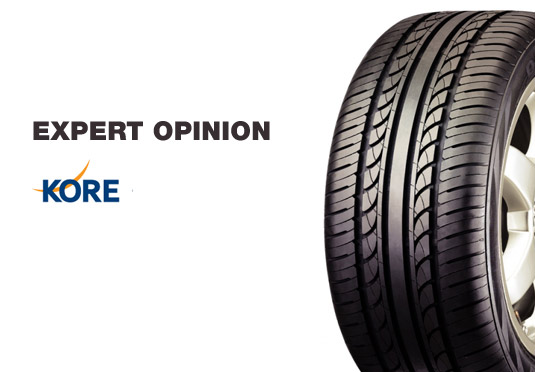The ‘Internet of Things’ buzzword appears to have picked up steam during the past several months as large players such as GE and Cisco have touted their stories on the growing number of connected devices. But, as Alex Brisbourne of KORE asks, how different, if at all, is the Internet of Things when compared with other connected device markets, such as machine-to-machine (M2M)?
When you boil it down to its elements, the Internet of Things (IoT) is, as it exists today, little more than an expansion of traditional telematics, security and asset control applications. If you look to the early days of stolen vehicle anagement, via LoJack and others, or basic tracking devices for children or Alzheimer patients, you know everything you need to know when it comes to the Internet of Things.

These devices communicate wirelessly with another device in the field, or back to a central server, to create value. But from these little acorns, oak trees of opportunity will flourish. The IoT really becomes transformative when devices start to communicate among themselves, disparate applications share and re-purpose data (think about your on-board car telematics data on how you are driving getting resold to the insurance company). It’s not far away, and it is based in the bedrock of today’s more lasersighted applications.
But there is another story here. Recent IoT talk has focused upon consumer-facing applications; most have not received significant traction, from pet and teen trackers to wireless car starters. The trouble is that few have stopped to consider the long-term value proposition. For example, if we look at the connected car via brands like OnStar or mBrace, there is definitely a big question mark about the sustainability of their subscription renewals. The initial subscription is an easy sale because it gets bundled into the purchase price, but the shimmer appears to wear off and not enough consumers seem to be motivated to carry the service beyond an initial term.
The real challenge here is that consumer-centric applications will always fight for a tightly squeezed share of disposable consumer income. The value proposition can be exciting at first but most often loses luster over time unless it is providing longterm tangible value.
Home automation is another area worthy of closer examination. There are some points of value, such as turning off a light from afar, adjusting a thermostat or checking if you left the oven on. Locking the door remotely makes sense, but do we need our toaster to tell our iPhone that our toast is ready?
It’s all about delivering value. Consider this: around 1 out of every 8 iPads sold today gets shipped with a cellular connection built in; but then, and this is the revealing part, only about 4% of those units have permanent subscriptions over time. If people aren’t willing to keep their iPads permanently connected, as this data suggests, can we really expect they’ll pay to keep their cars or their household lamps connected?
Ultimately, consumer-side IoT is going to have to conjure a “cannot live without” sentiment among consumers, in much the same way that cable television has done in most US households. Can this be done? Do they offer enough quality-of-life improving value for consumers to continue paying?
The rubber meets the road
On the commercial and public services side of the equation, the value is more evident. Going again to the connected car concept, vehicle manufacturers and leasing companies are designing IoT applications into their vehicles to provide remote maintenance monitoring, routing, fuel and mileage management, driver security, and other rich content. In these instances, the cost of integrating the application is miniscule compared to the earning potential of the vehicle. It makes fiscal sense.
There are, of course, limits to the impact of the current wave of IoT applications. In Singapore, for example, the government is building a connected traffic management system, complete with slidingscale road tolls based on time of day and traffic density. To do this, all vehicles are to be mandated to be equipped with on-board sensor devices. Such a concept can happen in a “command and control” society such as Singapore but when you talk about such mandates in North America, you get into a much different discussion. It is too big brother-like for cultural sensibilities, and needs investment in infrastructure that we appear to be reluctant to make.
There is, however, an interesting commercial version of this concept playing out in the auto insurance market, via “Pay-How-You-Drive” programmes reliant on vehicle sensor monitoring. You offer premium advantages by tracking policyholder behaviour more closely in real time.
In practice, however, we’re seeing this IoT application play out more as a marketing opportunity for insurers, where they offer would-be customers a chance to “prove their deservedness” for the better rate. And it’s not necessarily getting the expected results: we’re seeing that these devices often remain in service for only a matter of weeks or months. Apparently, the parties are not realising the expected value and stop the programme short. Does this mean that no US driver drives safe enough all the time?
Society benefits from IoT
Let’s now look at some other uses of the Internet of Things applications that stand to create real value, today.
Probably the biggest, and most powerful, use of the Internet of Things will be in telemedicine, and specifically for “wellness management”, or actively monitoring patients 24/7. In places like the US and continental Europe, medical management is about controlling costs, improving patient quality-of-life and, as a natural corollary, elevating treatment outcomes.
If I were to rank the top health conditions where telemedicine is already playing a role, they would be active heart monitoring and blood pressure monitoring for at-risk patients; automated glucose monitoring for diabetes patients; prescription compliance applications to eliminate wasteful re-prescribing; and sleep apnea support for investigatory and direct courses of treatment. Telemedicine can minimise the need for expensive Polysomnography exams and reduce expensive overnight hospital stays.
When you start thinking about connected medical devices, the world of “what’s possible” really does open up. In the case of prosthetic limbs, for example, embedded devices could deliver proactive maintenance alerts to patients and urgeons, as well as provide manufacturers with new information about how prosthetics “really” get used, what kind of wear and tear they experience and where the stress points are. The outcome here is to continuously improve how artificial limbs get made, optimise longevity and enhance wearability.
The Internet of Things also has a big role to play in helping to feed the world’s ever-growing population. For example, connected devices already help farms manage and automate irrigation, monitoring soil moisture levels and weather conditions to provide the perfect amount of water right when it’s needed. The supply chain actively measures time, temperature and air chemicals of perishables in transit to minimise spoilage. And, we see consumer versions of these concepts to alert home gardeners when individual plants need to be watered.
In Brazil, John Deere is programming its harvesters to use GPS and terrestrial data to help farmers grid the field for seeding, and to minimise overlap when cutting wheat. While it may seem small, an application like this delivers immense aggregate time savings, resource savings and field efficiency gains for farm operations.
Keeping IoT focused
There is truly no shortage of “futuristic” Internet of Things applications. However, there are also a myriad of IoT and more traditional M2M applications driving efficiencies and even revenue-generating services across vertical industries, from healthcare to fleet management to electronic payments.
The beauty of the IoT is that reliable and ubiquitous wireless connectivity from cellular, satellite and “near-field” networks is readily available and costefficient. I, for one, am excited to see the valuegenerating applications that will come to market in the next 12 to 24 months.
The author is Alex Brisbourne, president and COO of KORE (www.koretelematics.com), “the world’s largest wireless network provider focused exclusively on the rapidly-expanding machineto-machine (M2M) communications market.” He is a prolific speaker and opinion leader, and has become a staple at the semi-annual CTIA conferences.










